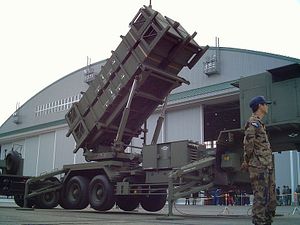After North Korea fired a ballistic missile over northern Japan early Tuesday morning local time, Japan is weighing next steps. North Korea’s provocation gives impetus for Japan to acquire a land-based Aegis missile defense system to complement its sea-based system, as well as to adopt an early warning satellite system.
Japan’s two-tiered missile defense system – consisting of Patriot Advanced Capability-3 surface-to-air missiles and the ship-based Aegis systems equipped with Standard Missile-3 interceptors – may not be up to the challenge. Upgrades are in the works, but several years out from completion.
Though the Defense Ministry is working to double the PAC-3 systems’ range, the work is expected to take until late fiscal 2019. They are also working with the U.S. to upgrade the SM-3 Block IIA interceptor, but work on this system is expected to take until fiscal 2021. Funding for the Aegis Ashore system was requested from the fiscal 2018 budget, but some in the ruling Liberal Democratic Party (LDP) are raising the possibility of beginning the process earlier by requesting part of the funds in the supplementary budget for fiscal 2017.
Though it will take several years to install, and the price must still be negotiated with the United States, just two Aegis Ashore systems with SM-3 Block IIA missiles could cover all of Japan. Another benefit of a land-based Aegis system is that it will reduce the workload of Self-Defense Forces members in missile intercept operations because their installment is permanent on land.
Japan currently has four Aegis ships properly equipped to defend all of Japan – three is the minimum. But four is just “barely” enough given that some ships will sometimes be out of service due to maintenance. The Defense Ministry wants to double the number of Aegis ships to eight, a goal that will likely not be reached until 2021.
The official explanation for Japan not shooting down North Korea’s missiles is that the missile was not a threat to Japanese territory and flew above its airspace. However, some experts suspect that Japan’s missile defense could not have shot it down, even if Japanese leaders wanted to.
Another key development to keep an eye on is how North Korea’s increased capabilities – and the United States’ tepid level of commitment to Japan’s security – shapes the debate within Japan about Japan’s nuclear deterrence. Notably absent from Donald Trump’s statement on the most recent missile tests is the boilerplate language reaffirming U.S. alliance commitments and role in providing regional security. Japan has also been unable to secure a commitment from the U.S. to allow Japan to install Spy-6, a powerful new radar system, should it acquire Aegis Ashore. Though the new interceptors will have a much greater range, without Spy-6, the old targeting radar may not be able to detect a threat until it is much closer.
As the United States under Donald Trump is seen as an increasingly unreliable ally, Japanese leaders may feel the need to pursue their own strategic hedge. However, don’t expect major shifts anytime soon. North Korea’s launch did not change either of the two most stubborn and significant structural factors holding back Japan: the Japanese public – which, decades later, is still wedded to the country’s self-conception as a “pacifist” country – and the risk of irreversibly escalating a regional arms race. Both the domestic political costs and the security risks vis-à-vis China are still way too high for any discerning politician to openly pursue such a policy option.

































